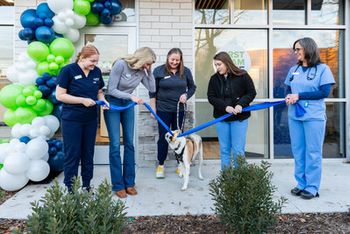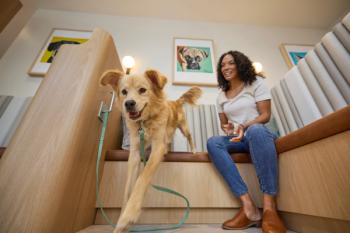
Hanging with Hafen: 3 tips for designing an efficient facility
Bigger isn't always better. While American veterinary practices have grown in size over the last few decades, international hospitals have remained more modest. Here's how to take a cue from your overseas counterparts and make the most of a small space.
Sometimes we get caught up in making things bigger and better. According to the U.S. Census Bureau, the average American home size in 2006 was 2,469 square feet. In 1970 it was just 1,500. Veterinary hospitals seem to be doing the same thing. But with the economy still relatively weak and construction costs still high, building the world’s largest clinic doesn’t make sense. Compounding the issue is the lack of ready financing for large projects and the increased cost—or unavailability—of raw ground zoned for veterinary hospitals. If you listen to your inner voice or look at the market, perhaps there’s a need to take on smaller projects. Let’s look at some old ideas made new.
GO MOBILE
James Herriot didn’t have a hospital at all. Instead, he practiced medicine on a kitchen table or in a barnyard. You can’t get much smaller than that.
In a typical 26-foot mobile veterinary van, the actual work area is 8 feet by 18 feet, or 144 square feet. The van often includes a combined treatment and surgery area, basic mobile radiography capabilities, counters, and caging. At an average transaction fee of $185, a veterinarian can gross as much as $80,000 per year in a room about the size of a living room. Income is limited only by how many clients you can drive to see in a typical day (probably eight in an eight-hour day).
THINK EUROPEAN
A few years ago, I had the opportunity to speak about veterinary design in Europe. Looking back, they must have thought I was from the moon. I think they were entertained by the mega hospitals I showed them, but I also think they were more than a bit appalled. Most hospitals in Italy are in the inner city and often occupy a small lease space on the first floor of an apartment building. In most cases, their veterinary hospitals are two rooms: the waiting/reception/office area and the exam/treatment/surgery/radiography/lab/storage area. These facilities are typically just a few hundred square feet. I’ve seen similarly sized facilities in Japan and China.
One of my firm’s clients in Queens, N.Y., has a hospital that was essentially built using the Italian model. When the owner first built that two-room hospital, he would have liked something larger, but space in the inner city was neither available nor affordable. This turned out to be a blessing in disguise. Eventually, as the practice expanded, he was able to make his rent by the afternoon of the first day of the month. As they say, the rest was gravy.
We went on to build a number of small facilities for this doctor. The largest one was only a couple thousand square feet. He called them “submarines” because they were long and about 20 feet wide, packed to the rafters with space-saving tricks.
Here’s one of the dirty little secrets of veterinary hospital design: Your net income will always be better in a small facility than in a large one. Architects like building bigger facilities, but the small ones are the most profitable.
We recently designed a veterinary hospital in Singapore. The working portion of the building, which included a waiting room, two exam rooms, a one-station treatment area, radiography, surgery, and a ward, was approximately 20 feet by 24 feet. It was small, but it worked.
Clearly, personal space varies by culture and geography. The American norm has been one exam room for every 1,200 square feet of building area. But in many of our more recent lease space facilities, it’s not unusual to see four exam rooms in 2,800 square feet, or one exam room per 700 square feet. Our design for Adobe Animal Hospital, a recent Veterinary Economics Hospital Design Competition Merit Award winner, had 18 exam rooms in 14,000 square feet, or one exam room per 780 square feet.
Here are three quick ideas for creating a more efficient hospital:
1. Make each room smaller. The typical size for a one-table surgery room is 10 feet by 12 feet, but some are as small as 8 feet by 10 feet. Set up all of the equipment you’ll need in a blank room and then draw a line around it. You’ll be amazed at how small it can be.
2. Eliminate functions. Over the past few years, the need for animal holding has dropped significantly. We now design facilities to house fewer animals, but make them more accessible and visible, most often in glass-fronted ICU wards adjacent to treatment. What other functions could you eliminate?
3. Combine functions. Going back to Dr. Herriot’s time, everything was done in one or two rooms. Now there’s a specialized room for everything. Treatment rooms have spun off separate dental, ultrasound, and endoscope rooms. Wards have been divided into day, isolation, intensive care, and intermediate care wards. In most of our facilities, we create a separate lab/pharmacy corridor that acts as a buffer between the exam rooms and treatment area. But it’s possible to combine some of these functions to fit your practice and space needs.
Like almost everything else in life, there are trade-offs. Not all of these strategies will work in every case, but they offer a place to start. Do you need a large, flashy facility or a small, efficient one? How much space do you really need to practice? What does the market demand? And what can you afford?
My daughter plays soccer. She’s only 5’4” and is very self-conscious about her height. But she’s the captain of her club soccer team and is one of the leading scorers. I tell her that size doesn’t matter, and I think she’s proven that to be true. Your veterinary hospital is the same way. Bigger is flashier, but is it necessarily better? You be the judge.
Newsletter
From exam room tips to practice management insights, get trusted veterinary news delivered straight to your inbox—subscribe to dvm360.




